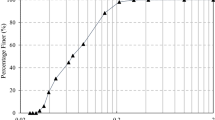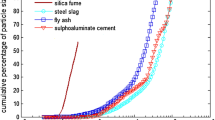Abstract
This paper investigates the physical properties of cement composites based on ordinary Portland cement (OPC) and silica particles as a potential material for porous aerostatic bearings for precision engineering applications. A full factorial design (2241) was carried out to study the effects of silica properties (size and geometry) and uniaxial pressure (10 and 30 MPa) on the composite properties, namely bulk density, apparent porosity and intrinsic permeability of the ceramic composites. Scatter graphs were plotted to identify the existence of significant correlations between parameters. The cementitious composite manufactured with small silica particles, non-spherical shape and low level of compaction pressure exhibited the most appropriate properties for the proposed application. In addition, mathematical models obtained from the response-correlation plots are potentially important tools for the development and design of new composites for porous bearing applications.










Similar content being viewed by others
References
Cheng K, Rowe WB (1995) A selection strategy for the design of externally pressurized journal bearings. Tribol Int 28:465–474. doi:10.1016/0301-679X(95)00011-R
Slocum A (1992) Precision machine design. Prentice Hall, New Jersey
Kwan YBP, Corbett J (1998) Porous aerostatic bearings—an update review. Wear 222:69–73. doi:10.1016/S0043-1648(98)00285-3
Fourka M, Bonis M (1997) Comparison between externally pressurized gas thrust bearings with different orifice and porous feeding system. Wear 210:311–317. doi:10.1016/S0043-1648(97)00079-3
Majumdar BC (1980) Externally pressurised gas bearings: a review. Wear 62:299–314. doi:10.1016/0043-1648(80)90175-1
Gargiulo EP, Gilmour PW (1968) A numerical solution for the design of externally pressurised porous gas bearings: thrust bearings. J Lubrif Technol Trans ASME Oct.: 810–817
Murti PRK (1976) Analysis of externally pressurised gas porous bearings. J Lubrif Technol Trans ASME 43:404–408
Polone J, Gorez R (1980) The use of ground material in gas lubrification. Wear 60:349–356. doi:10.1016/0043-1648(80)90233-1
Kwan YBP, Corbett J (1998) Slip inertia effects in porous aerostatic bearings. Tribol Int 31:779–786. doi:10.1016/S0301-679X(98)00101-7
Stout KJ, Barrans SM (2000) The design of aerostatic bearings for application to nanometre resolution manufacturing machine systems. Tribol Int 33:803–809. doi:10.1016/S0301-679X(00)00118-3
Bajza A (1983) Structure of compacted cement pastes. Cement Concr Res 13:239–245. doi:10.1016/0008-8846(83)90107-2
Cheeseman CR, Asavapisit S, Knight J (1998) Effect of uniaxial pressing ordinary Portland cement pastes containing metal hydroxides on porosity, density and leaching. Cement Concr Res 28:1639–1653. doi:10.1016/S0008-8846(98)00143-4
Recommendations of RILEM (1979) CPC 11.3: absorption of water by immersion under vacuum. June 1979
Cabrera JG, Lynsdale CJ (1988) A new gas permeameter for measuring the permeability of mortar and concrete. Mag Concr Res 40:177–182
Cabrera JG, Claisse PA (1999) Oxygen and water vapour transport in cement-silica fume pastes. Constr Build Mater 13:405–414. doi:10.1016/S0950-0618(99)00039-2
Jeff Wu CF, Hamada M (2000) Experiments: planning, analysis and parameter optimization. Wiley, New York
Montgomery DC (1997) Introduction to statistical quality control. Wiley, New York
Jambor J (1990) Pore structure and strength development of cement composites. Cement Concr Res 20:948–954. doi:10.1016/0008-8846(90)90058-6
Mcgeary RK (1961) Mechanical packing of spherical particles. Am Ceram Soc J 44:513–522. doi:10.1111/j.1151-2916.1961.tb13716.x
Nehdi M, Mindess S, Aïtcin PC (1998) Rheology of high-performance concrete: effect of ultrafine particles. Cement Concr Res 28:687–697. doi:10.1016/S0008-8846(98)00022-2
Robinson AT (1964) Permeability of tungsten matrices as a function of density, particle size and shape. Trans ASM 57:650–657
Cliffel EM Jr, Smith WE, Schwope AD (1966) Theory and applications of controlled permeability. Mod Dev Powder Met 3:114–128
German RM (1981) Porosity and particle size effects on the gas flow characteristics of porous metal. Powder Technol 30:81–86. doi:10.1016/0032-5910(81)85029-2
Smith DW, Marth T (1980) An examination of the effects of pore morphology on gas flow through sintered compacts. Mod Dev Power Met 12:835–854
Acknowledgements
The authors would like to thank the Department of Mechanical Engineering at the University of Bath, UK, and also the Department of Civil and Structural Engineering at the University of Sheffield, UK, for their support with the laboratory techniques. This project was funded by Capes, the Brazilian Ministry of Education Agency, to which the authors would also like to acknowledge.
Author information
Authors and Affiliations
Corresponding author
Rights and permissions
About this article
Cite this article
Panzera, T.H., Borges, P.H.R., Campos Rubio, J. et al. Physical properties of cement composites designed for aerostatic bearings. Mater Struct 42, 605–615 (2009). https://doi.org/10.1617/s11527-008-9407-5
Received:
Accepted:
Published:
Issue Date:
DOI: https://doi.org/10.1617/s11527-008-9407-5




